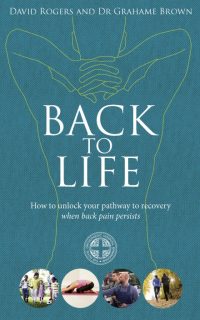Back pain is very hard to diagnose and to specify, hence heavy painkillers are thrown at people. But the only way to beat the pain is to understand it. David and Grahame have set up the Functional Restoration Service at the Royal Orthopaedic Hospital in Birmingham. They approach the management of pain using a biopsychosocial approach – where you feel the pain, what you believe causes it, and how everything else going on around you impacts on your symptoms.
Why does back pain become chronic?
Their book Back to Life explains how you can deal with back pain. The early chapters explain pain, your nervous system’s response and how the pain becomes chronic. You can begin to understand why you have back pain when all investigations show nothing is structurally wrong. As you get deeper into the book you gain little tips to make life easier. Many people avoid certain activities or movement because they fear pain, or are concerned about damaging their tissues. Back to Life can help you regain confidence in your day to day activities, whether it is putting on your socks or walking around the block.
Movement is the most important treatment
When you have persistent back pain you often learn to avoid activity and find everyday movements very difficult. Very quickly the complex nerve connections from your brain to the muscles of the back become redundant, making these activities even more difficult. Without regular movement, your back muscles can start to waste, and the muscle fibres, ligaments and tendons that connect the muscles to the bones shorten. This all contributes to the stiffness that you feel in the part of your body that has been in pain, creating more pain. The good news is that these changes are reversible, and Back to Life has a number of exercises that get these muscles working.
Over time, you will be altering the neural pathways, reinforcing healthy ‘I can do this’ messages from your spine to your brain. You are diluting the ‘this is very dangerous’ messages that can trigger a stress response, increasing your pain. You may not get rid of your pain completely, and Back to Life can help you deal with this. As your quality of life improves you will feel less pain.
Flare-ups
Back to Life also helps you deal with flare-ups. Anyone who has had years of back pain will know that sometimes the pain returns with a vengeance. This could be overdoing things, rushing back to normal activity or work too soon, or other stressful life events. Flare-ups will happen and using the relaxation and breathing techniques described can minimise the duration of your symptoms.
Conclusion
This well written book has been on my shelf for some time, and I use much of the content when helping people with chronic back pain.
Important: If you develop back pain with nerve type symptoms, including numbness, pins and needles or other symptoms you should be assessed by a healthcare professional.
For more information about how sports therapy can help click here
Learn how your psoas muscle may be causing your back pain by clicking here
To purchase Back to Life on Amazon click here






